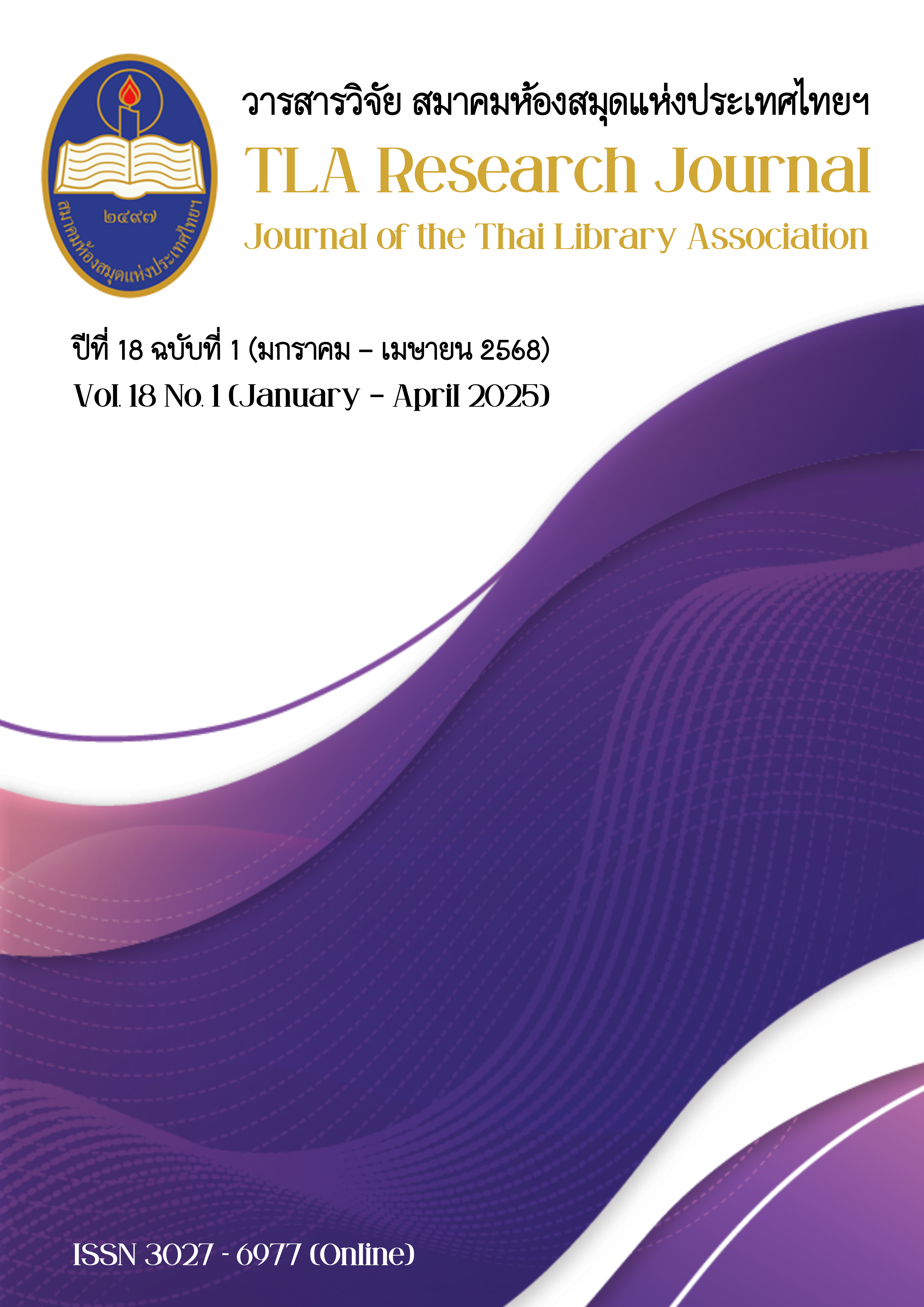The Model of Collaborative Network of Libraries and Information Service Institutions for People with a Visual Impairment in Thailand
Main Article Content
Abstract
This mixed-methods research aimed to develop a collaborative network model for libraries and information service institutions serving the visually impaired in Thailand. The model was informed by a survey examining the current conditions and challenges faced by these institutions, a review of relevant literature, and an evaluation of the draft model through focus group with 12 administrators and staff members from libraries and institutions for the visually impaired person. The model's appropriateness was assessed by 2 stakeholders of information service for the blinds. The findings revealed that the network model is a composite network using a bottom-up approach. Key activities driving the network's functionality include fostering cooperation among agencies with similar missions, establishing communication channels, and organizing joint activities such as forming a central working group, setting collaborative policies, building shared databases, conducting inter-agency training, and engaging external stakeholders.
Article Details

This work is licensed under a Creative Commons Attribution-NonCommercial-NoDerivatives 4.0 International License.
บทความทุกเรื่องที่ลงตีพิมพ์จะได้รับการตรวจอ่านโดยผู้ทรงคุณวุฒิ ความคิดเห็นและบทความที่ปรากฏในวารสารนี้ เป็นของผู้เขียนซึ่งมิใช่เป็นความคิดเห็นของคณะผู้จัดทำ และมิใช่ความรับผิดชอบของสมาคมห้องสมุดแห่งประเทศไทยฯ การนำบทความในวารสารนี้ไปตีพิมพ์ซ้ำต้องได้รับอนุญาตจากคณะผู้จัดทำ
All articles submitted for publication will be reviewed by the academic reviewers. The editorial board and TLA claim no responsibility for the content or opinions expressed by the authors of individual articles or columns in this journal. Reprinting of any articles in this journal must be permitted by the editorial board.
References
Brazier, H. and Owen, D. (2007). The roles and activities of the IFLA libraries for the blind section. Library Trends, 55(4), 864-878.
Clement, S. (2008). Skills for effective participation in consortia: Preparing for collaborating and collaboration. Collection management, 32(1-2), 191-204.
DAISY Consortium. (2024). Barriers to accessible reading in developing countries. Retrieved from https://daisy.org/news-events/articles/barriers-to-accessible-reading-in-developing-countries/
Department of empowerment of person with disabilities. (2024). Situation of people with disabilities in Thailand in August 2024. Retrieved from https://www.dep.go.th/images/uploads/files/31082567.pdf [in Thai]
Giordano, T. (2002). Library consortium models in Europe: A comparative analysis. Alexandria, 14(1), 41-52.
Gorman, G.E. and Cullen, R. (2000). Models and opportunities for library co‐operation in the Asian region. Library Management, (21)7, 373-384.
Kawai, Y. (2017). The guidelines of an education support model for visually impaired Japanese-major students in a higher education institute. Ganesha Journal, 13(1), 43–57. [In Thai]
Kolousek, J.E. (2021). A survey of services to visually impaired people in UK public libraries. (Master’s thesis). Loughborough University, United Kingdom.
Library of Congress. (2000). Bibliography for the blind: union catalog adds 38,000 records of British materials. Library of Congress Information Bulletin, 59(2). Retrieved from https://www.loc.gov/loc/lcib/0002/blind.html
Library of Congress. (2024) NLS: Who we are. Retrieved from https://www.loc.gov/nls/who-we-are/
Moghaddam, G.G. and Talawar, V.G. (2009). Library consortia in developing countries: an overview. Program: electronic library and information systems, (43)1, 94-104
Pal, J.K. and Das, P.K. (2007). Progress through partnerships: Consortia based E-resource subscription initiatives in India. Retrieved from https://digitalcommons.isical.ac.in/conf-articles/365/
RNIB. (2024). RNIB: About us. Retrieved from https://www.rnib.org.uk/about-us/
Sriwong, J., Harncharnchai, A., and Asvapoositkul, P. (2022). Investigation of the
current situation and problems of libraries and information service institutions for visually impaired person in Thailand. TLA. Bulletin, 66(1), 70–86.
Tripathi, A. and Lal, J. (2016). Library Consortia: Practical Guide for Library Managers. Kidlington: Elsevier.
Wijit, S. (2010). The operations of libraries for visually impaired people: Four case studies. (Master’s thesis). Srinakharinwirot University, Thailand. [In Thai]

